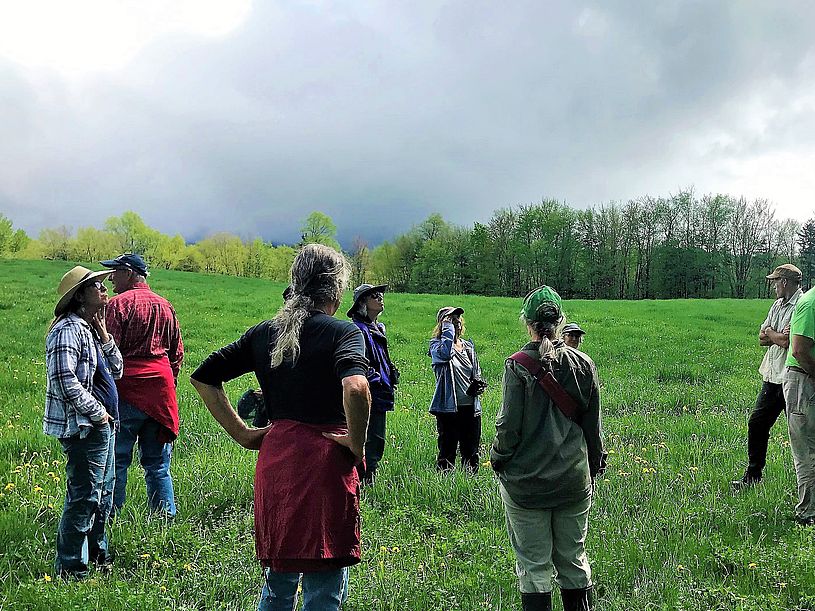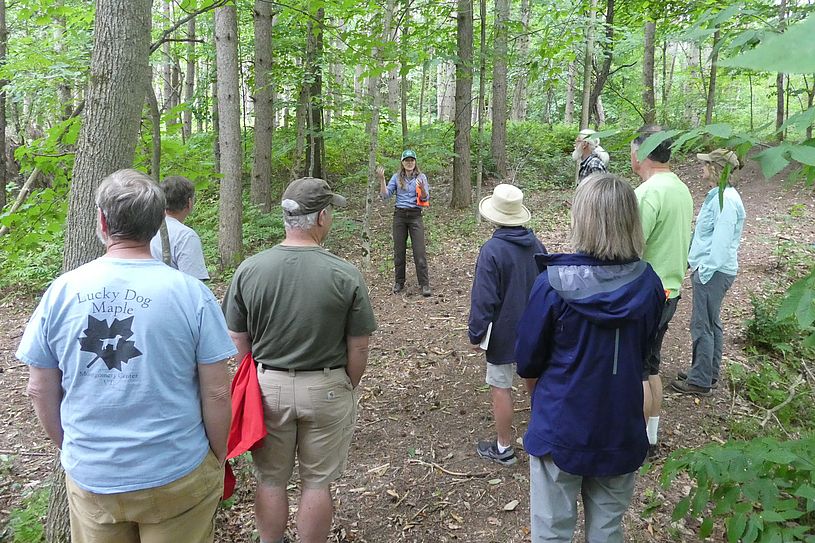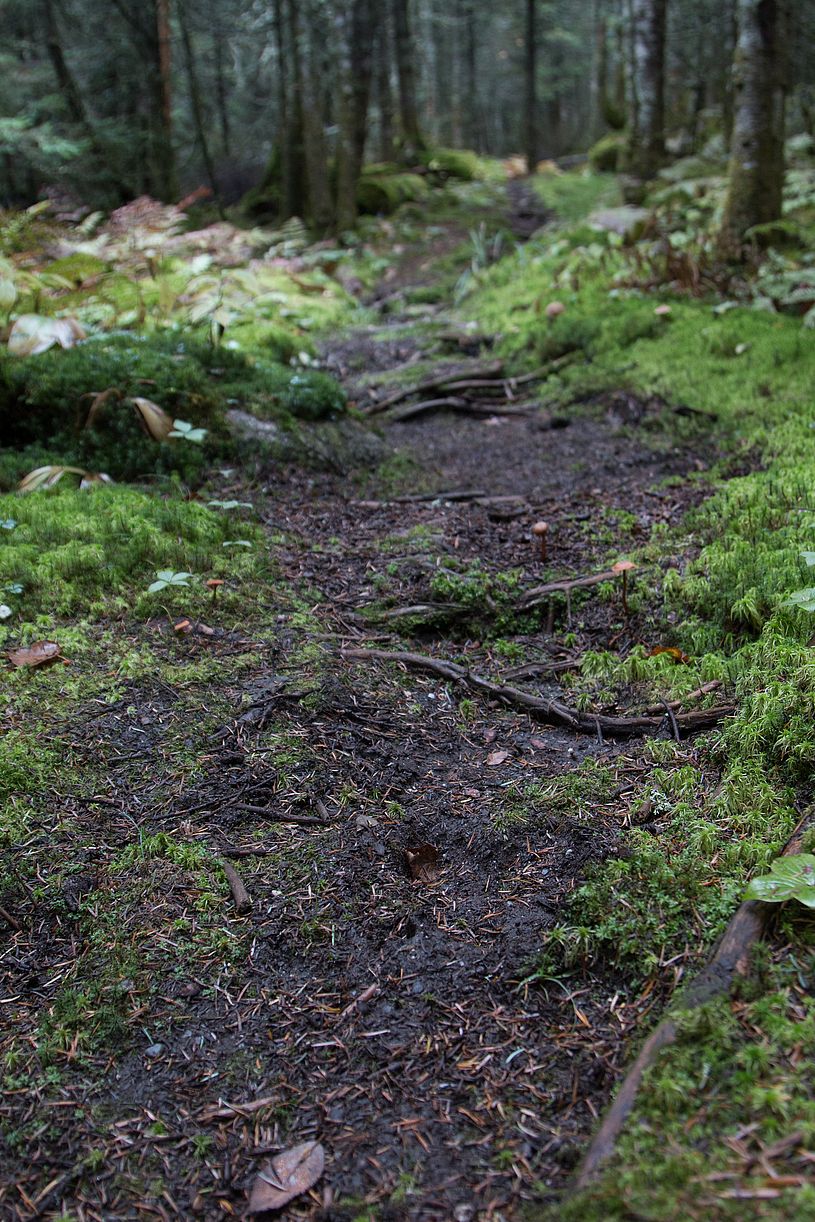Evaluation and the Long Term

Photo by Monica Przyperhart
Measuring Success
The Woodlots groups have been shown to have a high success rate for collaborative management addressing climate change adaptation, mitigation and resiliency, carbon storage and sequestration, enhancing wildlife habitat with a special focus on Neotropical Songbird Habitat, water quality, and forest improvement practices.
The program's expected outcomes include:
- Attendance/engagement during programs
- Incorporation of climate change analysis, forest songbird habitat assessments, and other sustainable forest practices into management plans
- Implementation of sustainable management practices
- Engagement with CHC partner opportunities
- Enhanced affordability of woodlands ownership
- Land protection
- (Eventually) Engagement of additional community members in stewardship/conservation/program involvement
Some of these are easier to track than others, and when CHC wants to gauge the success of the program, we often find that the best way to understand what we have achieved is to sit down with the landowner participants and hear their stories. It is through these stories that we understand the role the program plays in their lives–and in the future of Vermont’s forests.
However, our funders generally want more specific deliverables that show the impact of the program, so we also keep track of both quantitative and qualitative measures of success.

Photo by Monica Przyperhart
Quantitative measures
- Number of participants engaged in programming
- Number of participants engaged in resource activities
- Number of forest management plans that include climate resilience, forest resilience, or wildlife habitat measures
- Acreage and distribution of forest management plans that include climate resilience, forest resilience, or wildlife habitat measures
- Number of practices implemented with climate/forest resiliency or wildlife habitat in mind
- Acreage and distribution of practices implemented with climate/forest resiliency or wildlife habitat in mind
- Number of landowners expressing interest in land conservation initiatives
- Acreage and distribution of land conserved in long-term easements
Qualitative measures
Through participant surveys and interviews, we learn about qualitative measures, too, including:
- Participant satisfaction
- What participants have learned
- Changes in attitudes
- Perceptions on affordability
- Likeliness to conserve land
- Goals for land management–and changes in these goals due to the program
How is CHC Doing?
We have seen numerous successes toward these original goals. On the land conservation front, we attribute the conservation of over 3,000 acres of forestland (10 parcels) directly to the program, and we are deep in discussion with additional landowners interested in initiating the conservation process.
Sustainable stewardship is harder to quantify, but we'll provide several measures outcomes here:
- 56 parcels have received Forest Bird Habitat Assessments through Audubon Vermont. These assessments identify existing habitat for forest birds and suggest methods and locations for enhancing the habitat present.
- 65 parcels have received Climate Change Analyses. These analyses look at management plans to identify strategies landowners are already implementing to enhance forest resilience in the face of a changing climate. They also list additional strategies that a landowner can consider.
- 32 landowners have received assistance for incorporating the analyses above into Forest Management Plans. (There may be more. We only track these when financial assistance is requested.)
- 30 landowners have received assistance in implementing practices identified through Forest Bird Habitat Assessments, Climate Change Analyses, or other non-commercial sustainable stewardship measures. (Again, there may be more, but we only track practices when assistance is requested.)
- 107 landowners have participated in our Woodlots educational programming. (This represents 67 different land ownerships, as many are couples or family members.)

Allowing a Program to Mature
As programs mature, their needs are bound to change, as are the needs of individual landowners engaged in the program. Depending on your program’s goals, there are different ways to consider how to let your program do this.
When participants move on
Undoubtedly, there will be participants who are no longer able to engage, move, etc. What happens then?
Land Succession
When land passes hands, we try to engage the next owner of the property. After all, we know a fair amount about that land and have put time and effort into its stewardship. If we can keep it up, terrific! This doesn’t always happen, but we’ve been successful at engaging these new landowners in the continued stewardship of their land more often than we may have predicted. In fact, some new landowners have mentioned being attracted to a particular parcel because of the stewardship ethic of the previous landowners! It may be that engagement in this program actually attracts buyers who wish to continue in a similar vein.
When Life Happens
People are busy. It’s understandable.
It’s important to remember, too, that they’ll carry what they did get with them. We may not be able to track future stewardship, but that doesn’t mean it’s not happening!
Advancing the Content
Once a group has been established and participants have gone through the “basic” content of the program, it may be time for something new!
Expanding participation: Is it time to increase the reach of your program? We have found that the best resource for extending additional invitations is existing members. They often have ideas for community members who would be good matches for the program, and they are often even happy to reach out to welcome these new participants into the program.
Expanding Content: Some topics are more appropriate for "mature" groups. For example, many landowners aren't ready to discuss land conservation or land succession planning at the initiation of a Woodlots Program. After spending considerable time and energy focused on land management, however, discussing methods for protecting stewardship investments may be more attractive. As participants get to know and trust one another over time, these more personal topics may also become more comfortable to discuss in a group setting.
Expanding Geography: Another form of expansion could be including a wider geography. Rather than expanding a single program within the CHC region, we decided to initiate new programs when we expanded to new geographies--but this may or may not make sense for you!
Case Study: Enosburgh
The Enosburgh program is CHC’s oldest program. The program initially engaged the owners of 10 parcels. Several of the initial landowners conserved their land, several sold theirs, and several new landowners were engaged. Through all of this, the core group of landowners remained very loyal to the program. These neighbors had become very close friends, and while it’s impossible to identify exactly how much the program influenced the connections between these neighbors, the group was solid.
CHC’s original plan was that over time, the group would become self-sufficient (or nearly so), requiring very little of CHC’s time. A similar idea was that the group would have a volunteer “co-leader” who would assist CHC staff in organizing the program.
We still think that in some cases, this could work well. However, these are ideas very dependent on the individuals in the group. In this case, no one volunteered. At the same time, the staff coordinator felt like this wasn’t really necessary. Once she was running other programs, the coordination of any single program wasn’t much more effort. She also felt that coordinating with a volunteer co-leader may not actually be that helpful, as it may add one more piece of coordination to a complicated puzzle.
In the meantime, the program participants had changed over the 9 years of the program. Perhaps the biggest change was also the most obvious–and unavoidable: Core members were now 9 years older than when the program began. Mobility challenges began to surface among some. Topics of interest began to change, too, as several participants began to think about what would occur on the land when they were gone.
In a 2022 meeting of the group, we discussed possibilities for the group’s future. Here were some key takeaways:
- Desire for the program to continue was unanimous!
- The group needed coordination, and no one had the time or energy to volunteer. If there were to be a group moving forward, coordination would need to come from CHC.
- The group was interested in expanding participaton beyond the original members. Participants had several suggestions for new people to invite.
- The group was ready for a slight shift in content, with a focus on succession planning and land conservation strategies.
- The group also requested guest speakers who could share new ideas and topics, with some presenting in a "living room" setting. In other words, because mobility had become a challenge for some participants, this group suggested that programming include a mix of walks and stationary presentations.
- This group liked the idea of getting to know members of different Woodlots groups, in other towns, and occasionally having joint gatherings.

